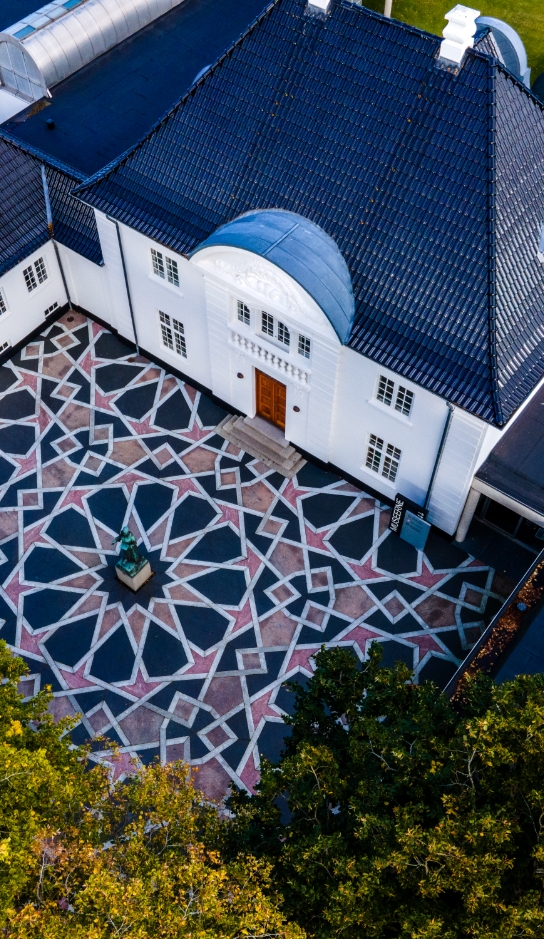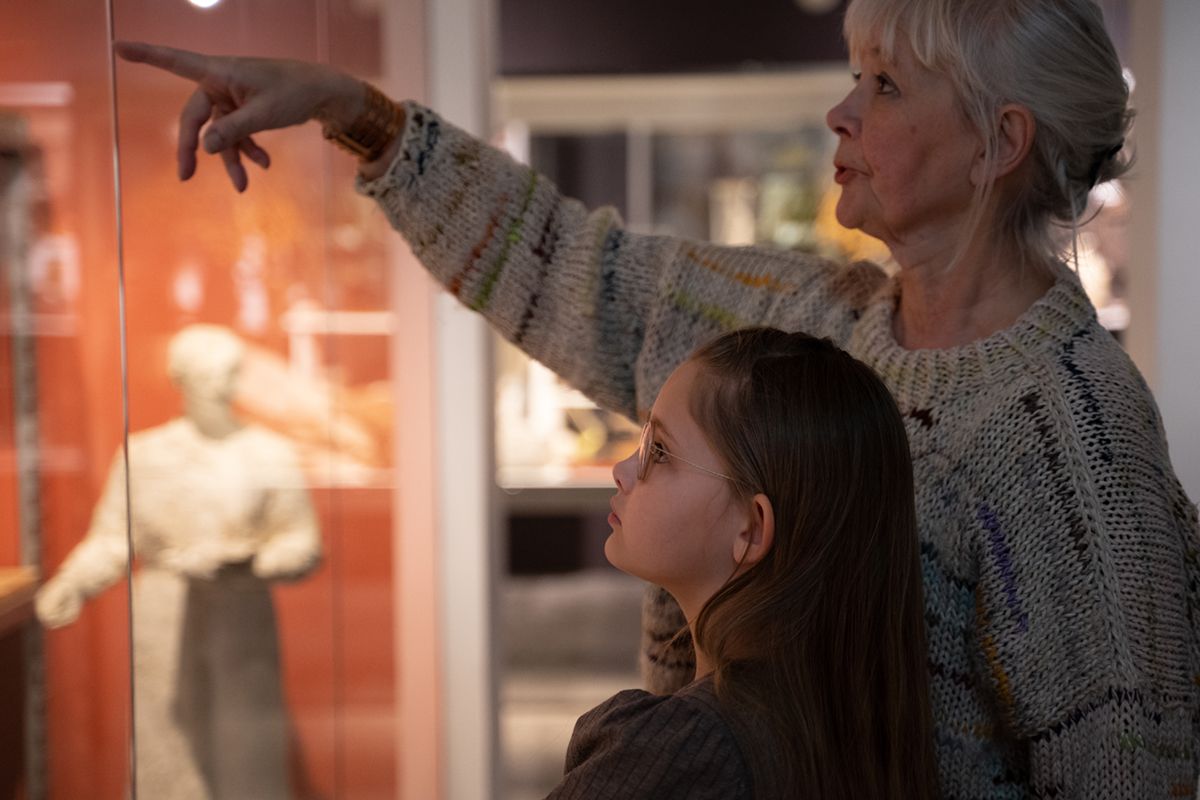Astrid Noack
Collection
The sculptor Astrid Noack (1888-1954) is one of the great and unusual personalities of the 20th century in Danish art. She was born in Ribe and trained as a sculptor at Vallekilde Folk High School in 1910. In 1935, Noack became the first female member of the experimental artists cooperative Grønningen. And she was again a pioneer in 2006, albeit posthumously, as the only female artist in the Danish Cultural Canon. All of this due to Noack’s craftsmanship, uncompromisingness and artistic integrity, as well as a predilection for the art of Antiquity and medieval Gothic sculpture. These connections back in time are by Noack transformed into a pure sculpture, yet full of intensity. Authoritative but never invasive.
Human comes first
The subject of Astrid Noack’s work is the human - often in its most characteristic position: the frontal. The discreet rotation of the body, the imperfect asymmetry of the ears, eyes and shoulders as well as the slightly displaced position of the hands or feet create a sensed tension in the figures. Noack’s techniques are so understated, so minimal that the sculptures appear all the more powerful and dignified; as almost abstract stories of the basic conditions of man, expressed through classical figuration. Astrid Noack’s contribution to the history of Danish sculpture is therefore placed in a rare, effective gap between tradition and modernity. Astrid Noack herself puts it this way: "The form must be felt from the core of the sculpture and carried outward in tight tension. No feeling or sensitive surface has any value unless it is supported by an internal structure. This is the abstraction in any sculpture, however different the form of expression".
The Study Collection
After Astrid Noack’s death in December 1954, the family founded the Astrid Noack Scholarship Foundation with the purpose of managing the artistic legacy of the sculptor. This included both the award of Astrid Noack’s scholarship to younger Danish sculptors as well as the management of the physical heritage. The scholarship is still awarded and in 2024, the foundation permanently entrusted the Study Collection
to Holstebro Kunstmuseum.
The museum already owned 52 works by Astrid Noack; the first was acquired in 1966, the year before the museum officially opened. With the addition of 88 sculptures and 103 drawings, which make up the Astrid Noack Study Collection - as well as a large archive consisting of the artist’s book collection, a correspondence archive, workshop books and photo archive - Noack’s artistry has been given a permanent home for posterity.
A large part of the works were preserved in connection with the donation; for instance the large original plaster casts of Astrid Noack’s main work Anna Ancher (1939), which is seen in bronze on the museum’s forecourt, and Ung mand der planter et træ (Young man planting a tree) (1952), which the artist worked on for almost ten years. The sculpture Knælende dreng (Kneeling boy) (1942) - which also, like Kvinde med klæde (Woman with clothes) (1943-44), can be found in bronze versions in the urban space - was quite damaged. The process of restoring the sculpture has been documented in the film Reversibel, which can be seen in the film archive in the museum’s Glass Corner or further down on this page. The above mentioned original plaster casts are part of this presentation in the lower floor of the museum along with for instance Noack’s very last work, the unfinished Kvinde med barn (Woman with child) (1954), placed centrally in the exhibition. The exhibition also includes selected works from the Study Collection, including several of Astrid Noack’s large sculptures and preparatory works. A display case contains different archival materials from the Noack archive, showing the artist’s work processes.
Artistic processes
As a whole, the Study Collection testifies to the tireless work of an artist with her material: Time and again, the human body is described in clay, plaster, bronze, cement and stone. The bodies are made in varying scales, and Noack spent many years trying to figure out the exact weight and volume of a sculpture. It was also not unusual for Noack - even after an original plaster cast for a sculpture had been cast from the first and perishable version in clay - to take a file and chisel and work on it. These so-called original plaster casts dominate the sculptures in the Study Collection and are often known by their characteristic yellowish surfaces, usually the result of release agents applied in connection with castings of them in plaster and bronze.
When it becomes easy, it’s worthless
In an interview in 1951, Astrid Noack said that her work was easier than the work of painters, because her work was so physically demanding: "I also have the advantage over, for example, a painter that there is so much manual work with - pure craftsmanship. The stone has to be cut, it takes many hours of work, and it is healthy and promotes balance. The craftsman in me enjoys that part of the work". And she continues: "When it becomes easy, it’s worthless, from an artistic point of view. Each new work is a battle that you have to fight with humility […] It’s like with people you care about".
FILM AND RADIO INTERVIEW
Reversibel - Konserveringen af Astrid Noacks Studiesamling
Since the autumn of 2023 - leading up to the opening of the special exhibition Human Comes First - The Astrid Noack Study Collection (Holstebro Kunstmuseum Nov 16, 2024 - May 4, 2025) Conservator Therese Gry Asla from The Danish Center for Conservation and Preservation of Art, who specializes in sculpture, has been working on preserving and stabilizing many of the sculptures in the Study Collection. As the months went by, she gained special insights and knowledge of Astrid Noack's techniques and processes which was made accessible in the exhibition through this documentary film, Reversibel - Konserveringen af Astrid Noacks Studiesamling.
The film is produced by Morten Ka Asla / 3rdEye Productions in collaboration with The Danish Center for Conservation and Preservation of Art.
Astrid Noack for posterity: three contemporary perspectives
Martin Erik Andersen, sculptor and visual artist
Hanne Pedersen, art historian
Kirsten Dufour, visual artist
The films are recorded and produced for the special exhibition Human Comes First - The Astrid Noack Study Collection by visual artist Kristina Steinbock, 2024.
Radio Interview | Astrid Noack on the statue 'Anna Ancher'
Astrid Noack talks about her portrait statue Anna Ancher (1939), DR - the Danish Broadcasting Corporation (February 18, 1948).
Photo | Astrid Noack working on her statue of Anna Ancher. Detail of a photo taken by the artist's niece, Getrud Westergård.
BOOK PUBLICATIONS
Human Comes First - The Astrid Noack Study Collection
In 2024, Holstebro Kunstmuseum published the book Human Comes First - The Astrid Noack Study Collection, which documents and puts the collection as a whole into an art historical perspective. The book is available at the museums shop NB: in Danish
Stronger than Life: Astrid Noack 1888-1954. Woodcarver and Sculptor
In 2025, art historian Hanne Pedersen’s authoritative biography of Astrid Noack, Stronger than Life: Astrid Noack 1888–1954. Woodcarver and Sculptor (2008), has been reprinted by Holstebro Kunstmuseums Forlag. The book is available at the museum shop NB: in Danish, English Summary
"When it becomes easy, it’s worthless, from an artistic point of view. Each new work is a battle that you have to fight with humility while standing and recognising your powerlessness and how terribly far there is yet to go – and yet you love the battle. It’s like with people you care about."
Astrid Noack, 1951


![The Astrid Noack Study Collection, <i>Anna Ancher</i> [portrait statue], 1939<br>Original draft, plaster. Photo: Lars Bay](/f/blog/article/2326945ae219d8fcfea4a9e3f8bf5b68adf15362_thumb.jpg)
